Canon EF 35mm f/2 IS USM
In December of 2012 Canon updated their 35mm f/2 lens – at last! As you can tell from the longer name, the new EF 35mm f/2 IS USM finally features an ultrasonic autofocus motor and also introduces an image stabilizer. It is a completely new construction. As to my knowledge, this is the first 35mm prime lens for the Canon system (or maybe any?) with an image stabilizer and you might well wonder if this technology is helpful in a moderate wide-angle lens. With this lens, Canon completes the line of non-L wide-angle primes after the 24mm f/2.8 and 28mm f/2.8 had been upgraded to new versions earlier in 2012 – now also featuring USM drives and image stabilization. These are my thoughts about the EF 35mm f/2 IS USM.
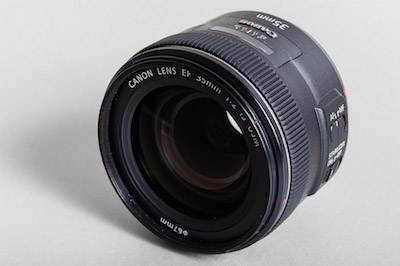
Lens Basics
The first incarnation of a 35mm lens for the EF system had been introduced by Canon in late 1990 and when I started to use autofocus cameras in 1999 I had decided to not go with that lens though I had been very happy with the corresponding FD lens on my former cameras. Instead, I went for the EF 28mm f/2.8 – I was on a student budget back then and got hold of a used one at a reasonable price. For many years I pondered exchanging that lens for one of 35mm focal length. With the EF 35mm f/2 being a rather old design with an arc form drive (AFD) autofocus motor and the EF 35mm f/1.4L USM being the only – expensive and bulky – alternative offered by Canon, I was hoping for a successor of the EF 35mm f/2 with USM drive. I waited for year after year, but nothing like that came out of Canon’s production.
In November of 2012 Canon finally announced the new 35mm lens which had grown considerably compared to the old version: It weighs 50% more than the old one and also is much bigger in diameter and length with a filter size of 67mm. Just as with the other new primes, the build quality seems much better to me than that of the older lens – it is plastic, but of a very different variety than that of 1990. The mount is made of metal, as with most EF lenses. The front lens does not rotate during focusing so that, while the lens is not labeled as sealed, there is little chance for water or dust to get inside.
In contrast to the predecessor, the new lens now has a ring-type USM drive which is fast and almost silent and allows for full time manual override. The minimum focus distance is 0.24m, yielding a maximum magnification ratio of 0.24 (which is almost the same as it was with the old lens). The focus throw is about 150 degrees with the scale ranging from 0.24m to 2m and then infinity.
The optical construction is very different from the old one, with 10 elements in 8 groups where the old lens had 7 elements in 5 groups. One of the lenses is a glass-molded aspherical element, and one element can be shifted to achieve image stabilization. While Canon claims their image stabilization to be good for 4 stops, resulting in exposure times of up to half a second, I usually don’t take hand-held shots with this lens at exposure times of more than 1/4 second which is usually no problem. The lens switches to panning mode when the built-in gyro sensor senses a corresponding movement. Also, the lens is supposed to “know” when you are shooting from a tripod so that there should be no need to turn it off though of course you always can if you want to.
When I bought the lens in early 2013, I was not convinced that image stabilization was anything I needed or wanted to have in a wide-angle lens. I would have preferred a lens without that feature – which would have cost less: At that time the lens was way too expensive with a retail price of some $850. Under normal circumstances I would not buy a lens so soon after it has been introduced. This is not so much for fear of the lens having problems or wanting to wait for thorough reviews but rather for the expectation of a drop in retail prices – probably not significantly but at least a bit. However, circumstances were not normal then as I was about to leave for a trip of six weeks to New Zealand and wanted to have a decent wide-angle lens in my pocket. Canon then reduced the price substantially to $600 within less than a year of its date of release and I have quickly begun to appreciate the stabilization feature.
The rendition of out-of-focus areas is pretty good thanks to the eight rounded aperture blades. Despite the price, Canon does not include a lens hood. Thus you need to buy the petal-shaped EW-72 for another fifty-something dollars or a cheaper alternative from a third party like the JJC LH-72. The lens cap is of the new center-pinch variety that allows for easier attaching and detaching when a lens hood is mounted.
Optical Performance
I don’t have the means to do any serious testing under lab conditions – for some results by such tests see below – but have taken a couple of test shots to give an impression of the lens’ performance. The photos shown here were taken from a tripod with a Canon EOS 6D at Wewelsburg, some 15km south of Paderborn, Germany. The sequence shows photos taken at every full aperture stop, starting at f/2 all the way down to f/22. These images only show the performance at different apertures.

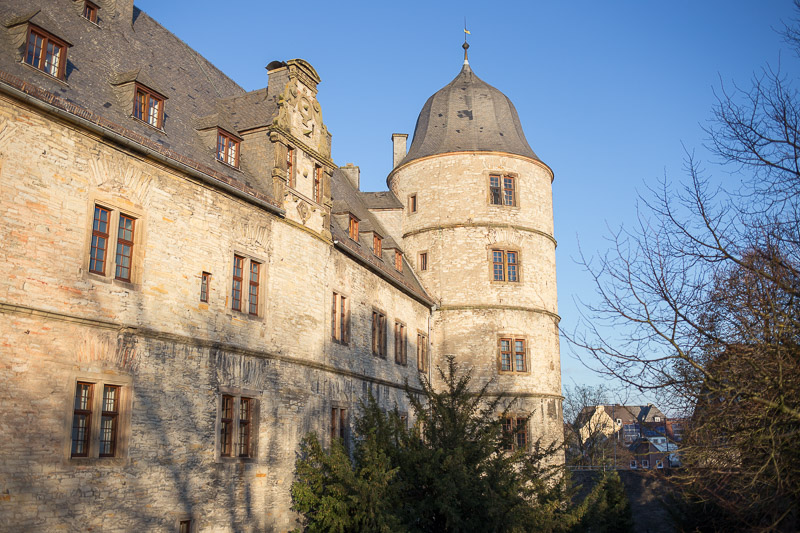

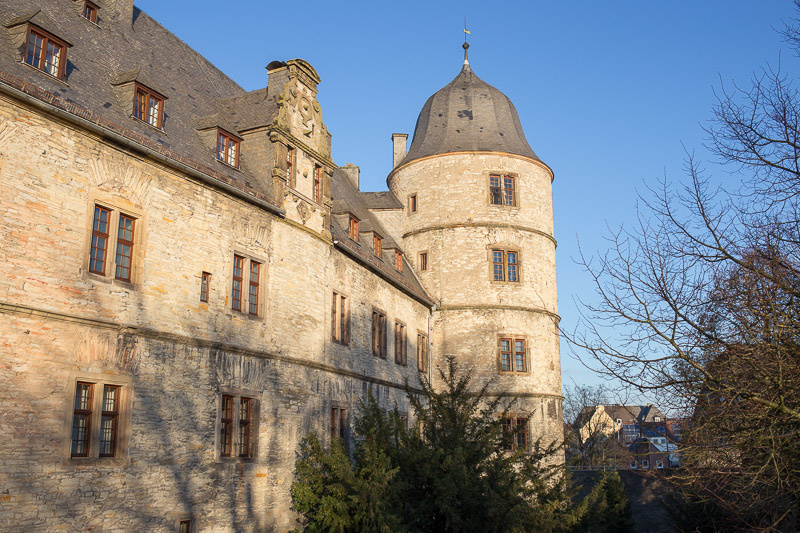




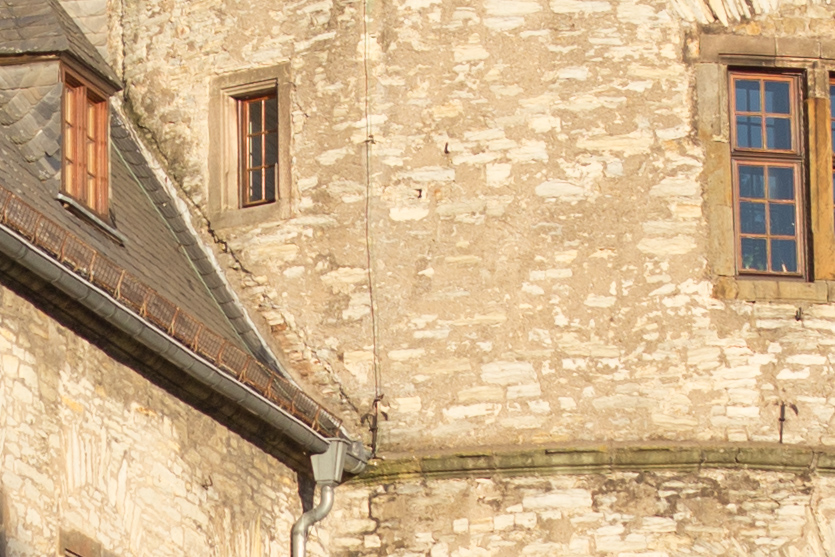
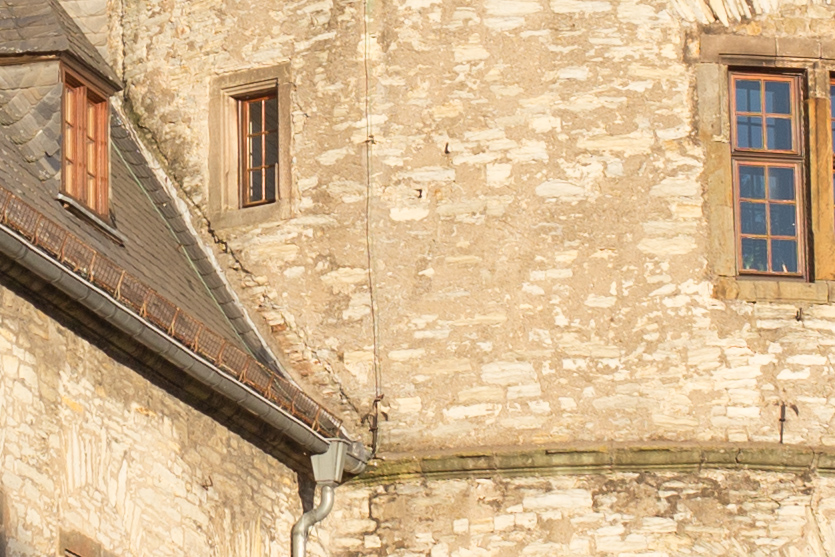

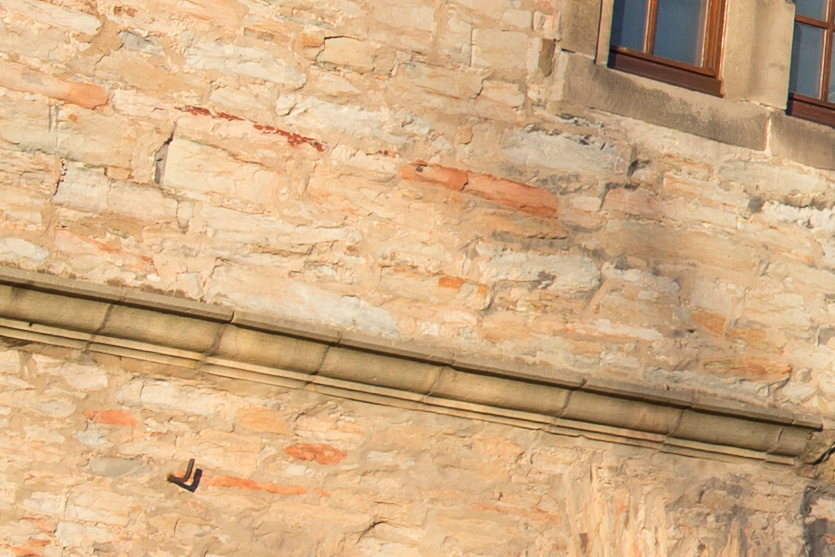
All of these photos have been taken as RAW images and were imported into Adobe Lightroom with the standard settings of that software. I removed a couple of sensor dust spots, reduced the lights by 50 and moved up shadows by 50. The photos were then exported with standard sharpening for the screen. Versions of the images in full resolution can be found in my Flickr album Samples EF 35mm f/2 IS USM; you will find more test shots as well as some real-world photos taken with this lens in that album.
Vignetting is quite strong at f/2 – not only in the corners but even along the edges – and still pretty obvious in the corners at f/2.8. Things look quite fine from f/4 onwards, though there still is some vignetting as you can easily see when you use the lens corrections in the processing software. Vignetting is one the things that can be easily corrected when processing the images; at f/2 you will need to increase the brightness in the corners quite a bit to remove vignetting, thus adding noise.
For all practical purposes the lens is pretty sharp right from f/2 into the corners. The lens shows its best performance – to no surprise – from f/4 to f/11. Zooming in on the photos to 200% or 300%, you can notice the effect of the aperture. Close to the center where the piping leads down from the roof, you can see a slight improvement when stopping down from f/2 to f/2.8; from there on to f/8 there is virtually no difference while at f/11 diffraction starts to kick in very slightly, increasing on the way to f/22. If you zoom in to that little metal piece in the wall at the left side of the photo, you will notice that this bit is less sharp at f/2 and f/2.8 while from f/4 to f/8 it remains sharp before it gets a little blurry again from f/11 onwards. The decrease in sharpness wide open might be due to depth of field as this point is rather close to the camera; other test shots, however, show the same behaviour. Looking at the window in the roof in the top left corner again at 200% or 300%, you can see that sharpness increases from f/2 to f/5.6 which is almost identical to f/8 in sharpness. From f/11 to f/22 sharpness decreases again to due diffraction. From a practical point of view, I would probably try to avoid f/2 and maybe even f/2.8 in situations where sharpness in the corners is critical. In many situations, however, this is not the case and usually we shouldn’t be looking at images at 100% or more so that the lens is perfectly usable wide open.
Chromatic aberrations are practically not existing with this lens, at least in field use. So far, I have not bothered to tick Lightroom’s option to remove chromatic aberrations for any photos that I have taken with this lens. The lens also has very little distortion so that I usually don’t correct for that.
As usual, my comments refer to the use of the lens on a full-frame camera, the Canon EOS 6D. On APS-C sensors the lens will behave differently in several aspects.
Measured Data
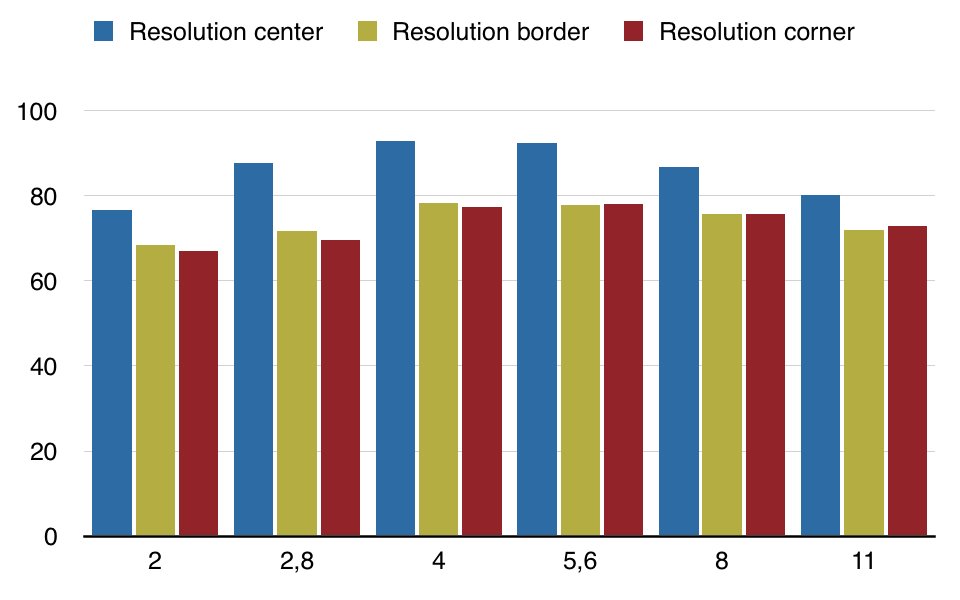
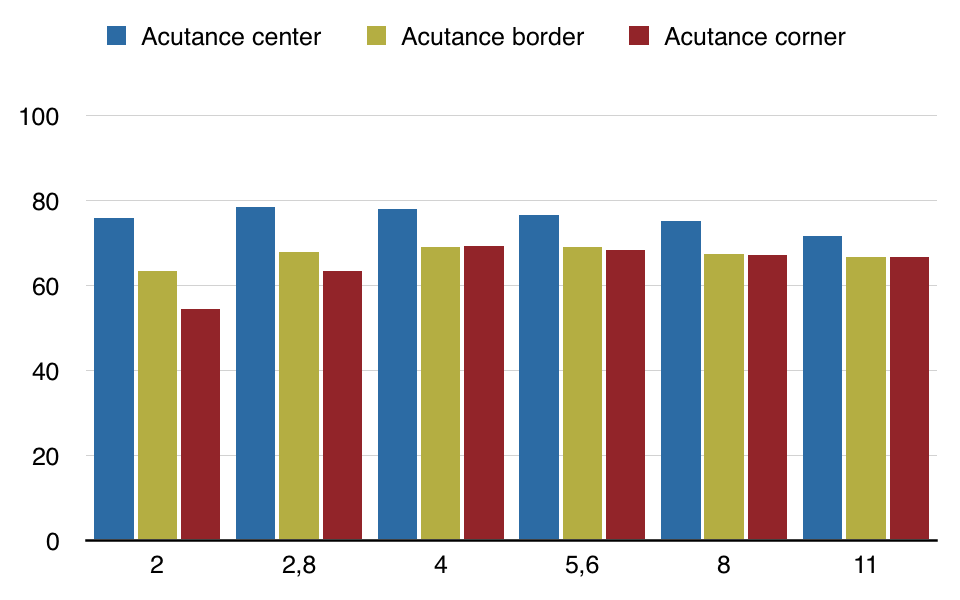
Comparing the observations made above with the resolution data from Photozone’s test, the results seem to be pretty similar. I have converted their results to a scale ranging from 0 to 100 with the complete scale shown here so that differences between the values are not exaggerated – values of 70 or more translate to “very good”, values higher than 80 to “excellent”.
According to their test, the image center is very good at f/2 and excellent from f/2.8 to f/11, where diffraction starts to take effect. Photozone finds the lens to be slightly better at f/4 and f/5.6 than at f/8 whereas to me f/5.6 and f/8 seem to deliver the best results. At the borders and even in the corner, the lens is judged as very good, almost reaching the excellent level at f/4 and f/5.6. While there is little difference between borders and corners according to their test, the impression from my photos is that the corners are a little less sharp than the borders even at f/4. Photozone mentions that the contrast is lower in the outer areas of the images, thus affecting resolution.
The acutance data from the DxO Mark test (as measured on a 5D Mark III) match the observations made above in some aspects while in others they diverge. According to those data, the center is virtually at the same level from f/2 to f/8 with the best values at f/2.8 and f/4. In contrast to Photozone, their data suggest that the corners at these apertures are not as sharp as the borders which is in line with my observations. Again, they find the lens to be sharpest at f/4 and f/5.6 at the borders and in the corner while I believe to see an increase in corner sharpness from f/4 to f/5.6 when scrutinizing the images. Since DxOMark does not explain if the measured acutance data translate to “good”, “very good” or the likes, the interpretation of their absolute values lies with you.
Vignetting according to Photozone is 2.2 EV at f/2, while according to DxO Mark it is 1.8 EV. At f/5.6 and beyond it is about 0.56 EV or 0.5 EV respectively at the two test sites.
More Image Samples
The following photos have received a full treatment in Lightroom. Versions of the images in full resolution can be found in my Flickr album Samples EF 35mm f/2 IS USM along with more sample photos.






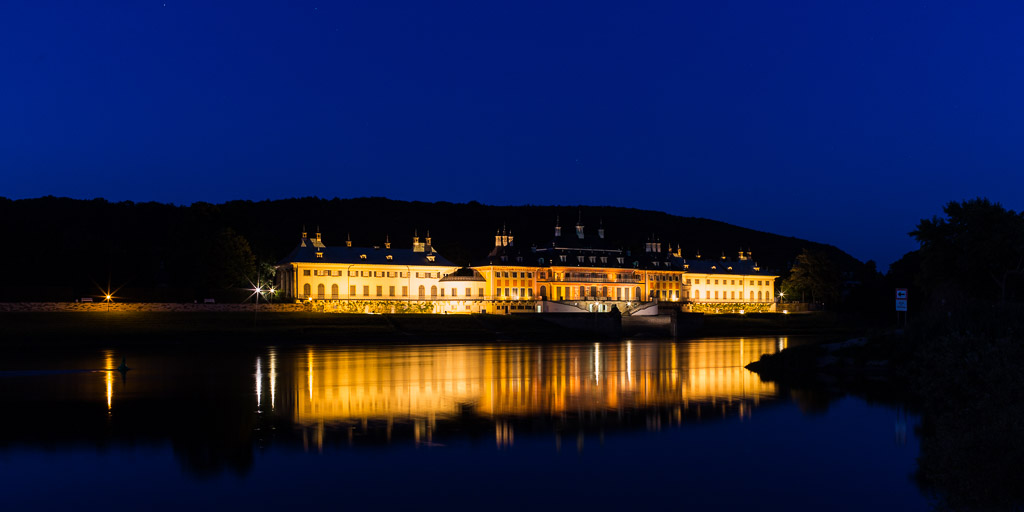

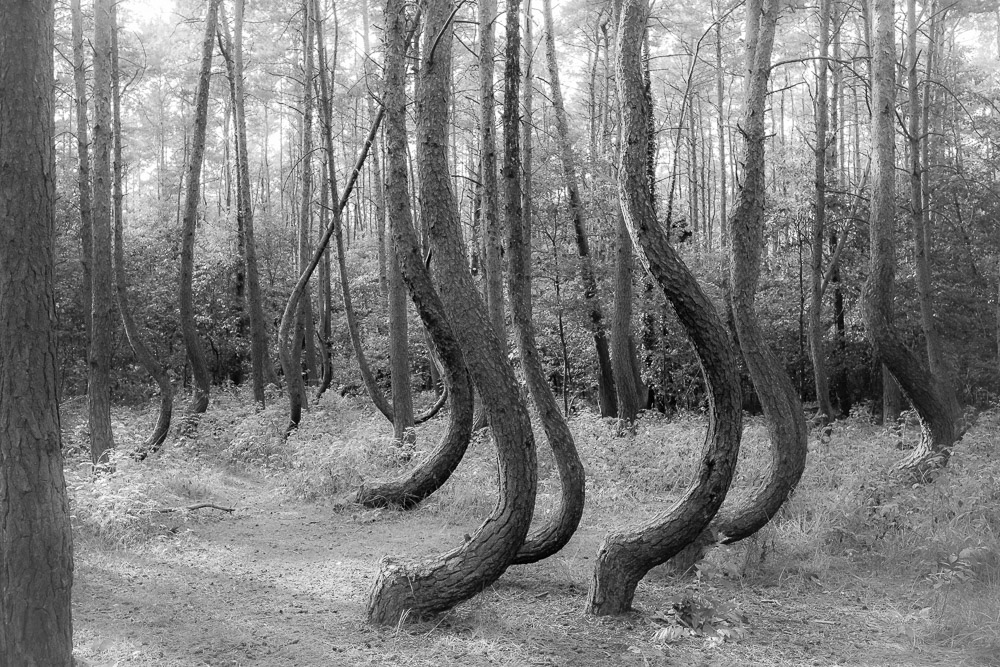

Other options
There are plenty of 35mm lenses to choose from; I haven’t used any of them and thus can only make some general remarks which probably won’t tell you anything you didn’t know already. In August 2015, Canon introduced the EF 35mm f/1.4L II USM. While its predecessor was said to be quite soft in the outer areas of the image at wider apertures, the new lens seems to be pretty sharp across the entire image at all apertures, just like the Sigma 35mm F1.4 DG HSM | A. Both of these lenses are much bigger beasts with a maximum aperture of f/1.4 and weigh twice as much or more than the EF 35mm f/2 IS USM; both also don’t have an image stabilizer. The Sigma costs about 50% more than the lens reviewed here, while the EF 35mm f/1.4L II USM costs more than three times as much. Yet another alternative might be the Tamron SP 35mm F/1.8 Di VC USD with a maximum aperture closer to the lens reviewed here. It also includes an image stabilization (vibration control in Tamron lingo). Reviews of this lens, however, have been mixed; so I’d recommend looking at different reviews if you consider to buy it.
There are also some quite interesting manual-focus lenses available at 35mm. If you can live without autofocus, the Samyang 35mm f/1.4 AS UMC might be worth a look – with a price tag close to the lens reviewed here, but a maximum aperture of f/1.4. The Zeiss Milvus 35mm f/2 is another option, being one of the most affordable lenses in the Zeiss line-up.
Finally, there are plenty of zoom lenses that cover the 35mm focal length – far too many to list them all. It seems, however, that none of them – even the most expensive ones – is as sharp as the EF 35mm f/2 IS USM at the widest common aperture or in the corners. If corner sharpness isn’t that important to you and if you usually use apertures of f/5.6 or f/8, a zoom lens might be the way to go for you – as long as size and weight don’t matter. There seems to be one exception to this rule, and that is the Sigma 24-35mm F2 DG HSM | A which seems to deliver a brilliant quality across the image even wide open. However, you should also keep in mind that most of the differences are between “very good” and “excellent”.
Final Remarks
The EF 35mm f/2 IS USM is my standard lens: This is the lens that I use most and if I were to take only one prime along on any trip, this would be the one. For my main subjects, landscape and architecture, most of the images are taken at f/5.6 or f/8 where this lens is really great. Vignetting is usually no problem, yet I like to remove it when processing the images. Chromatic aberrations and distortion are so low, that in almost all cases I don’t bother to remove them. Image stabilization is a feature that I use much more often than I thought I would. It works great, especially when taking hand-held shots inside buildings or at night in the city where you sometimes can’t or don’t want to set up a tripod.
I can only recommend this lens. Its optical quality is great, it is pretty small and light-weight (though not as small and light as its predecessor or the EF 40mm f/2.8 STM). If, however, you need the wide open apertures, the lenses mentioned above with a maximum aperture of f/1.4 are worth considering. They not only offer the wider aperture, but also perform better at f/2. On the other hand, those lenses don’t offer image stabilization so that in low-light situations the lens reviewed here might still be the better choice. Among the zoom lenses, the Sigma 24-35mm F2 DG HSM | A is probably the best regarding image quality at 35mm. Compared to other zoom lenses the zoom range is very narrow, but it still covers three popular focal lengths. With all other zooms, it’s a trade-off between image quality, maximum aperture, size, and weight on the one side and the convenience of a range of focal lengths on the other.
Specifications
| Optical construction | 10 elements in 8 groups |
| Angle of view | 54° horizontally; 38° vertically; 63° diagonally |
| Apertures | 2 to 22 with 8 rounded lens blades |
| Minimum distance | 0.24m; maximum reproduction factor: 0.24 |
| AF motor | ring-type USM with full-time manual focusing |
| Front element | non-rotating with 67mm filter thread |
| Image stabilizer | 4 steps |
| Dimensions | 78mm wide; 63mm long; 335g |
Read more here
Review at Optical Limits (a.k.a. Photozone)
Dustin Abbott’s Review
Bryan Carnathan’s Review
